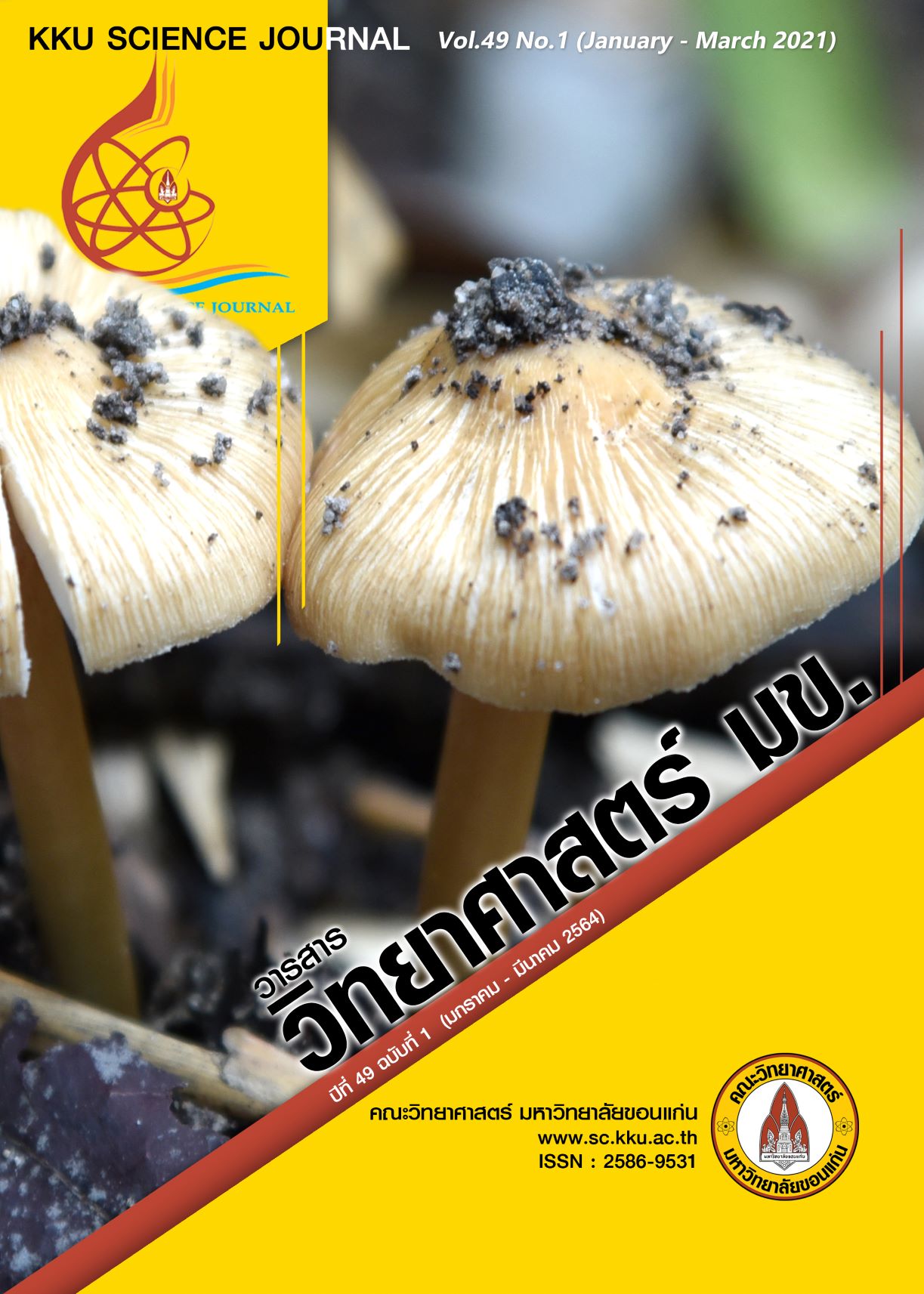การผลิตกล้าเชื้อด้วยเทคนิคอินฟิวชั่นเพื่อใช้เป็นต้นแบบในการผลิตหัวเชื้อแบรดีไรโซเบียมในระดับกึ่งอุตสาหกรรม
Main Article Content
บทคัดย่อ
แบรดีไรโซเบียมเป็นแบคทีเรียที่มีประโยชน์ต่อพืชตระกูลถั่วเมื่ออาศัยอยู่ร่วมกันภายใต้สภาวะพึ่งพาซึ่งกันและกัน โดยอาศัยกระบวนการตรึงไนโตรเจนของเชื้อแบรดีไรโซเบียมที่เป็นที่รู้จักกันโดยทั่วไป สำหรับงานวิจัยนี้มีวัตถุประสงค์เพื่อพัฒนาเทคนิคอย่างง่ายที่สามารถใช้กล้าเชื้อในปริมาณน้อยเพื่อการผลิตหัวเชื้อแบรดีไรโซเบียมที่มีคุณภาพสูงในรูปแบบต่างๆ โดยในงานวิจัยนี้เริ่มต้นจากการเตรียมกล้าเชื้อ Bradyrhizobium diazoefficiens USDA110 โดยการเจือจางเชื้อด้วยวิธีทำมือเพื่อให้ได้เชื้อที่ความเข้มข้น 10 ถึง 106 โคโลนีต่อหน่วย ก่อนนำไปปลูกเชื้อเพื่อผลิตหัวเชื้อในรูปแบบต่างๆ ผลการทดลองพบว่า ระดับการเจือจางเชื้อที่มีจำนวนเซลล์ต่ำที่สุดเมื่อนำไปใช้เป็นกล้าเชื้อ ยังคงตรวจพบการเจริญของเชื้อได้ต่อไป โดยเมื่อใช้กล้าเชื้อจำนวน 10 โคโลนีต่อหน่วยสำหรับการปลูกเชื้อพบว่าเชื้อสามารถเจริญต่อได้มากกว่า 108 โคโลนีต่อหน่วย เมื่อบ่มเชื้อที่ระยะเวลา 14, 21 และ 14 วัน ในหัวเชื้อรูปแบบเหลว รูปแบบผสมในวัสดุพาหะ (พีท) และรูปแบบผสมเม็ดวุ้น ตามลำดับ ดังนั้นจำนวนเชื้อที่ความเข้มข้น 10 โคโลนีต่อหน่วย จึงนำมาใช้ในการทดสอบการผลิตหัวเชื้อด้วยเทคนิคอินฟิวชั่น โดยนำ syringe pump ต่อเข้ากับ peristaltic pump เพื่อทำให้ได้กล้าเชื้อจำนวน 10 เซลล์ต่อหน่วย ก่อนฉีดเข้าไปเพื่อผลิตหัวเชื้อรูปแบบต่างๆ แบบกึ่งอัตโนมัติเพื่อเป็นต้นแบบในการผลิตหัวเชื้อในระดับกึ่งอุตสาหกรรมโดยผลการทดลองพบว่า หัวเชื้อ แบรดีไรโซเบียมทุกรูปแบบที่ผลิตด้วยเทคนิคนี้มีจำนวนเชื้อเพิ่มขึ้นและมีอายุการเก็บรักษาได้นานอย่างน้อย 3 เดือน ดังนั้นงานวิจัยนี้จึงเป็นงานแรกที่แสดงให้เห็นว่า การใช้กล้าเชื้อที่เจือจางในระดับที่มีจำนวนเซลล์น้อย สามารถใช้ในการผลิตหัวเชื้อได้จึงทำให้ไม่จำเป็นต้องเตรียมกล้าเชื้อในปริมาณมากในการผลิต ดังนั้นกระบวนการนี้จึงสามารถนำไปประยุกต์ใช้กับการผลิตหัวเชื้อแบรดีไรโซเบียมที่มีคุณภาพสูง-ต้นทุนต่ำ ในระดับกึ่งอุตสาหกรรมได้ต่อไป
Article Details

This work is licensed under a Creative Commons Attribution-NonCommercial-NoDerivatives 4.0 International License.
References
Albareda, M., Rodríguez-Navarro, D. N., Camacho, M. and Temprano, F. J. (2008). Alternatives to peat as a carrier for rhizobia inoculants: solid and liquid formulations. Soil Biology and Biochemistry 40: 2771–2779.
Bashan, Y. (1986). Alginate Beads as Synthetic Inoculant Carriers for Slow Release of Bacteria That Affect Plant Growth. Applied and Environmental Microbiology 51(5):1089-1098.
Bashan, Y., Hernandez, J. P., Leyva, L. A. and Bacilio, M. (2002). Alginate microbeads as inoculant carrier for plant growth-promoting bacteria. Biology and Fertility of Soils 35(5): 359-368.
Dart, P. J., Roughley, R. J. and Chandler, M. R. (1969). Peat culture of Rhizobium trifolii an examination by electron microscopy. Journal of applied bacteriology 32(3):352-357.
Daza, A., Santamaría, C., Rodríguez-Navarro, D. N., Camacho, M., Orive, R. and Temprano, F. (2000). Perlite as a carrier for bacterial inoculants. Soil Biology and Biochemistry 32(4): 567–572.
Denton, M. D., Phillips, L. A., Peoples, M. B., Pearce, D. J., Swan, A. D., Mele, P. M. and Brockwell, J. (2017). Legume inoculant application methods: Effects on nodulation patterns, nitrigen fixation, crop growty and yield innarrow-leaf lupin and faba bean .Plant and Soil 419: 25-39.
Einarsson, S., Gudmundsson, J., Sverrisson, H., Kristjansson, J. K and Runolfsson, S. (1993). Production of Rhizobium Inoculants for Lupinus nootkatensis on Nutrient-Supplemented Pumice. Applied and Environmental Microbiology 59(11): 3666-3668.
Feng, L., Roughley, R. J. and Copeland, L. (2002). Morphological changes of rhizobia in peat cultures. Applied and Environmental Microbiology 68(3): 1064-1070.
González-López, J., Rodelas, B., Pozo, C., Salmerón-López, V., Martínez-Toledo, M. V. and Salmerón, V. (2005). Liberation of amino acids by heterotrophic nitrogen fixing bacteria. Amino acids 28(4): 363-367.
Kannaiyan, S. (2002). Biotechnology of biofertilizers. Oxford: Alpha Science International Limited.
Malusá, E. and Vassilev, N. (2014). A contribution to set a legal framework for biofertilisers. Applied Microbiology and Biotechnology 98(15): 6599-6607.
Mohamed, S. S., Hassan, M. A. and Abdelgani, M. E. (2019). The shelf life of Rhizobial liquid inoculants amended with different polymeric additives. Australian Journal of Basic and Applied Sciences 13(11): 28-36.
Roughley, R. J. and Vincent, J. M. (1967). Growth and Survival of Rhizobium spp. in Peat Culture. Journal of Applied Bacteriology 30(2): 362-376.
Saiprasad, G. V. S. (2001). Artificial seeds and their applications. Resonance 6(5): 39-47.
Sethi, S. K. and Adhikary, S. P. (2012). Cost effective pilot scale production of biofertilizer using rhixobium and Azotobactrt. African Journal of Biotechnology 11(70): 13490-13493.
Shakhawat, H. M. and Mårtensson, A. (2008). Potential use of Rhizobium spp. to improve fitness of non-nitrogen-fixing plants. Acta Agriculturae Scandinavica, Section B-Soil and Plant Science 58(4): 352-358.
Shcherbakova, E. N., Shcherbakov, A. V., Rots, P. Y., Gonchar, L. N., Mulina, S. A., Yahina, L. M., Lactionov, Y. V. and Chebotar, V. K. (2018). Inoculation technology for legumes based on alginate encapsulation. Agronomy Research 16(5): 2156 2168.
Somasegaran, P. (1985). Inoculant production with diluted liquid cultures ofRhizobium spp. and autoclaved peat: Evaluation of diluents,Rhizobium spp. peats, sterility requirements, storage and plant effectiveness. Applied and Environmental Microbiology 50(2): 398–405.
Somasegaran, P. and Hoben, H. J. (2012). Handbook for rhizobia: methods in legume-rhizobium technology. New York: Springer Science and Business Media.
Temprano, F., Albareda, M., Camacho, M., Daza, A., Santamaria, C. and Rodríguez-Navarro, N. D. (2002) Survival of Several Rhizobium/Bradyrhizobium Strains on Different Inoculant Formulations and Inoculated Seeds. International Microbiology 5(2): 81-86.
Tittabutr, P., Payakapong, W., Teaumroong, N., Singleton, P. W. and Boonkerd, N. (2007). Growth, survival and field performance of bradyrhizobial liquid inoculants formulations with polymeric additives. Science Asia 33: 69-77.
Žvagiņa, S., Petriņa, Z., Nikolajeva, V. and Lielpētere, A. (2015). Immobilization and survival of root nodule bacterium Rhizobium leguminosarum biovar viciae. Material Science and Applied Chemistry 32: 75-79.
Singleton, P., Keyser, H. and Sande, E. (2002). Development and evaluation of liquid inoculants. In ‘Rhizobial inoculants and nitrogen fixation in Vietnam. ACIAR Proceedings No. 109e. (Ed. DF Herridge) pp. 52–66.

